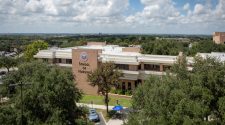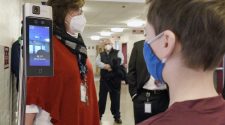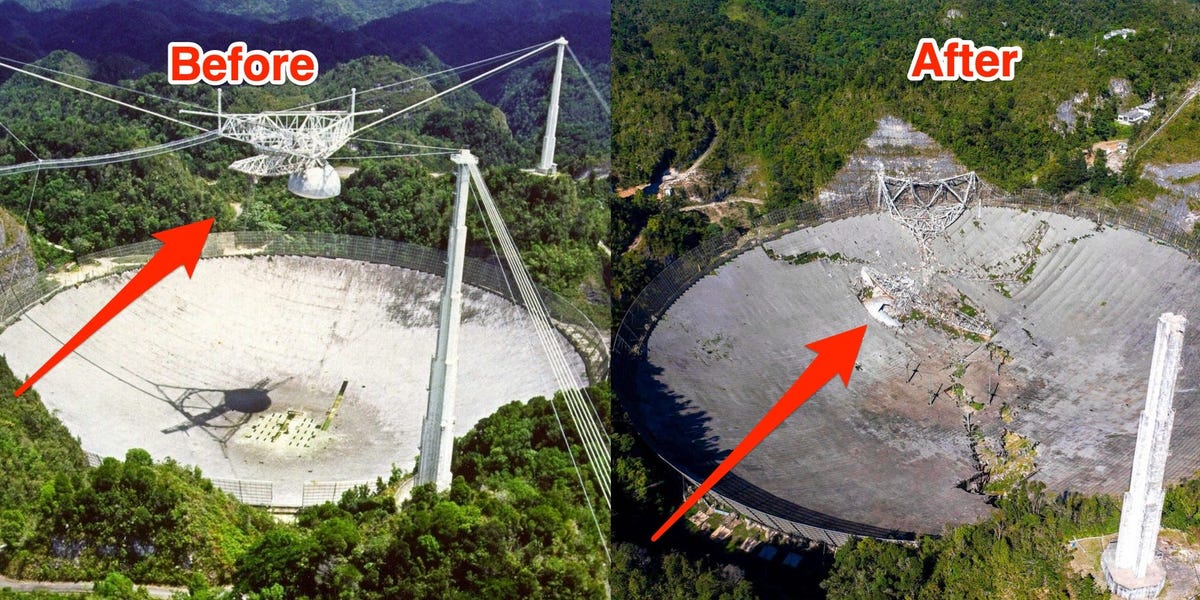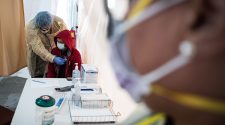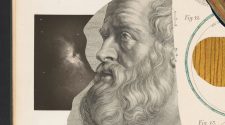- The Arecibo Observatory’s radio telescope collapsed Tuesday morning, when its 900-ton suspended platform crashed into the enormous dish below.
- Arecibo was one of Earth’s best radio astronomy tools for 57 years. Its death is a blow to asteroid-tracking efforts and the hunt for alien life.
- Photos of the iconic telescope show what it looked like before and after the crash.
- Visit Business Insider’s homepage for more stories.
The Arecibo Observatory’s enormous radio telescope collapsed on Tuesday morning. Its 900-ton platform crashed into the 1,000-foot-side disk below, yanking down the tops of three support towers as it fell.
The demise was not entirely a surprise. After the telescope suffered two cable breaks in August and November, the National Science Foundation, which owns the telescope, determined it was too structurally unsound for workers to repair safely. The Foundation decommissioned the Puerto Rico telescope in late November, and engineers were working to figure out how to deconstruct it. But the platform crashed before that work could progress.
Courtesy of the Arecibo Observatory, a US National Science Foundation facility
“Friends, it is with deep regret to inform you that the Arecibo Observatory platform has just collapsed,” Deborah Martorell, a meteorologist in Puerto Rico, tweeted in Spanish on Tuesday morning.
Before the crash, the telescope’s massive platform hung 450 feet in the air above its giant bowl-shaped disk. The disk reflected radio waves from space to instruments on the suspended platform.
Universal Images Group via Getty Images
But on Tuesday morning, cables that connected the platform to one of the towers snapped, sending it plummeting down.
Jonathan Friedman, who has worked on the Arecibo Observatory’s scientific staff since 1993, told local news outlet NotiCentro the collapse sounded like the rumble of an earthquake, a train, or an avalanche.
Ricardo Arduengo/AFP/Getty Images
A life spent hunting asteroids and starring in movies
Since it was completed in 1963, the Arecibo telescope has played a role in some of humanity’s most exciting findings about space.
It discovered the first known planet beyond our solar system, sent out powerful broadcasts for potential aliens to intercept, and tracked potentially hazardous asteroids to see whether they could hit Earth.
It even helped scientists confirm Einstein’s theory of general relativity by detecting the first binary pulsar: a highly magnetized, compact star orbiting another star.
Arecibo also enabled researchers to hunt for radio waves from potential alien technology. The only other radio telescope that equals Arecibo’s former power is China’s Five-hundred-meter Aperture Spherical Radio Telescope (FAST).
The telescope’s scale and setting also led it to a life onscreen: It starred in the 1995 James Bond film “GoldenEye” and the 1997 movie “Contact,” starring Jodie Foster.
Francois Duhamel/Sygma via Getty Images
Scientists around the world are mourning the loss of the Arecibo telescope, but it was of special significance to many in Puerto Rico, where it drew 90,000 visitors a year. It also served as a training ground for graduate students in astronomy, physics, and other space-related disciplines.
“When I learned of the news, I was totally devastated,” Abel Mendez, the director of the Planetary Habitability Laboratory at the University of Puerto Rico at Arecibo, told Business Insider in November, after the telescope was decommissioned.
Mendez had been around the observatory since he was 10 and worked with it professionally for a decade.
“It’s hard to take. It’s like losing someone important in your life,” he said. “Yeah, 2020 — it’s not good.”
Morgan McFall-Johnsen, Aylin Woodward, and Dave Mosher contributed reporting.


